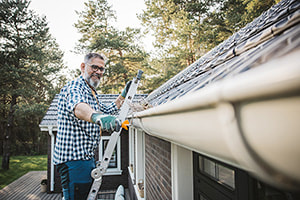 Thinking about upgrading your kitchen, giving your bathroom a fresh look, or finally building that dream deck? Before you dive in, be cautious—while many contractors are reputable, some take advantage of unsuspecting homeowners. Here's how to spot four common contractor scams that could turn your dream renovation into a costly nightmare. 1. The Disappearing Deposit A contractor asks for a hefty upfront deposit—sometimes as much as 50%—then vanishes, leaving you with an unfinished project and an empty wallet. A trustworthy contractor typically requires no more than 10%–15% to cover initial materials. Always sign a legally binding contract before making any payments, and ensure that the payment schedule is tied to specific project milestones. 2. The Surprise Upgrade Midway through the project, your contractor insists you need unexpected repairs or upgrades, suddenly driving up costs. While some issues are legitimate, others are tactics to squeeze more money out of you. Before agreeing to extra work, get a second opinion. A well-defined contract should outline the project scope and how unforeseen issues will be handled, helping you stick to your original plan unless you truly want changes. 3. The Too-Good-to-Be-True Bid A bid that's much lower than others may seem like a steal, but it often leads to cheap materials, rushed work, or hidden costs that pile up later. Compare multiple estimates and look for a contractor with solid reviews. A reasonably priced bid from a well-rated professional is usually the safest choice. 4. The Vague Contract Vortex A contract filled with vague terms, missing details, or unclear pricing is a recipe for disputes, delays, and frustration. Without specifics on materials, timelines, and payment schedules, you may end up paying more for less. Insist on a clear, detailed contract that leaves no room for misunderstandings—this ensures your renovation stays on track. Your home is your sanctuary, so renovations should be exciting, not stressful. Stay aware of common scams to protect your investment and bring your vision to life—stress-free.
0 Comments
 Plumbing issues are not only a huge inconvenience but can also lead to expensive repairs. From clogged pipes to leaky faucets or even a backed-up sewer system, plumbing problems come in various forms. Fortunately, preventive maintenance can help you avoid many of these issues and keep your plumbing system running smoothly. Here are six practical tips to consider. Mind What You Flush Flushing the wrong items down the toilet is a common cause of clogs and major blockages. Items like wipes, cotton balls, paper towels, diapers, and even small toys can lead to serious plumbing issues. Teach your family, especially children, about what should and shouldn't be flushed to avoid unnecessary repairs. Regularly Inspect Your Pipes One of the simplest ways to prevent plumbing problems is by routinely inspecting your pipes. Look for small cracks, leaks, rust, or signs of wear and tear. Rust or corrosion can weaken pipes, increasing the chances of future issues. If you spot any trouble, it's best to contact a plumber right away before the problem escalates. Install a Water Softener Hard water is a silent culprit behind many plumbing problems. Mineral deposits can accumulate in your pipes and appliances, leading to reduced efficiency and premature wear. Installing a water softener helps remove these minerals, protecting your plumbing system and extending the lifespan of your water heater and other appliances. Plus, it improves the taste of your water. Be Cautious with Your Garbage Disposal Garbage disposals are convenient but aren't designed to handle everything. Avoid pouring grease, oil, or fibrous foods like banana peels into the disposal. These materials can clog pipes or damage the disposal's blades. Always run plenty of cold water while using the garbage disposal to help flush food particles through the system effectively. Use a Drain Strainer A drain strainer is an inexpensive and effective way to keep food particles and debris from slipping into your drains, where they can cause clogs. Simply place the strainer over your drain to catch anything that shouldn't go down, and empty it regularly to prevent blockages. Monitor Your Water Bill A sudden spike in your water bill is often a telltale sign of a hidden leak. Regularly check your water bill, and if you notice a significant increase, inspect your pipes and faucets for leaks. Some leaks are easy to fix on your own, but for more complex issues, it's wise to call a professional plumber. Preventing plumbing problems before they start is key to maintaining a healthy, functional home. While you can tackle minor issues yourself, don't hesitate to call a professional plumber when needed. These simple maintenance tips can keep your plumbing running smoothly and help you avoid expensive repairs.  For the first time since July 2021, year-over-year existing-home sales climbed in October, which is a sign of optimism for the housing market. According to the National Association of Realtors (NAR), sales increased 3.4% month over month and 2.9% year over year. What's more, every sales region saw sales climb from September and three regions posted year-over-year growth. According to Lawrence Yun, chief economist for the NAR, "The worst of the downturn in home sales could be over, with increasing inventory leading to more transactions." Housing demand is also increasing due to continuing job gains and economic growth. Housing Affordability Challenges Although housing sales are up, buyers are still facing challenges in the form of rising home prices and elevated mortgage rates. October's median existing-home price climbed 4% year over year to $407,200. Not only was October the 16th month in a row of price growth, but every sales region across the country reported price increases. "The ongoing price gains mean increasing wealth for homeowners nationwide," noted Yun. Buyers will benefit in the coming months, meanwhile, as additional inventory and new home construction are expected to increase supply and moderate price growth in the coming year. Further improving affordability, mortgage rates are now starting to stabilize, with the 30-year fixed-rate mortgage averaging 6.77% in mid-November, down from 7.44% a year earlier. Distressed sales, including foreclosures and short sales, accounted for just 2% of all transactions, suggesting that despite affordability challenges, there remains stability and confidence in home values. Inventory Increasing and Sales Pace Shifting In more positive news for buyers, total housing inventory climbed to 1.37 million units in October, a slight 0.7% increase from a month ago and an impressive 19.1% increase from a year ago. At the current sales pace, this level of supply would last 4.2 months, down from September's 4.3-month supply but higher than the 3.6-month supply posted in October 2023. Additionally, homes spent more time on the market in October, averaging 29 days before selling in comparison to 23 days a year earlier. The additional time on the market reflects the deliberate pace buyers and sellers are setting as everyone adjusts to current market conditions. Trends Among Buyers Mortgage financing is one of the main challenges first-time buyers will face. While rates remain elevated, Yun believes they will stabilize, ensuring first-time buyers will remain represented in the market. This group of buyers accounted for 27% of all home purchases in October, up from 26% a month ago but down from 28% a year ago. Cash investors were responsible for 27% of all purchases, down slightly from 30% a month ago and 29% a year ago. Individual investors and second-home buyers, who account for many all-cash purchases, represented 17% of the market in October, up from 16% in September and 15% in October 2023. Regional Sales Breakdown Northeast: Existing-home sales annual rate of 470,000; an increase of 2.2% from September 2024 but unchanged from October 2023. The median sales price of $472,900 represented a 7.6% increase from October 2023. Midwest: Existing-home sales annual rate of 950,000; an increase of 6.7% from September 2024 and 1.1% from October 2023. The median sales price of $305,300 represented a 7.2% increase from October 2023. South: Existing-home sales annual rate of 1.77 million; an increase of 2.9% from September 2024 and 2.3% from October 2023. The median sales price of $361,200 represented a 0.9% increase from October 2023. West: Existing-home sales annual rate of 770,000; an increase of 1.3% from September 2024 and 8.5% from October 2023. The median sales price of $627,700 represented a 4.4% increase from October 2023.  So, you’re thinking about buying a home in the Bay Area? That’s exciting! But let’s be real—this market is one of the toughest in the country. Prices are high, competition can be fierce, and interest rates aren’t exactly doing buyers any favors. But here’s the good news: smart buyers can still find great opportunities. If you’re wondering whether now is the right time to jump in, keep reading. This could be YOUR moment to finally own a piece of the Bay. Why Is the Bay Area So Expensive? And Is It Worth It?The Bay Area has always been a hot real estate market, and for good reason: 🌟 Incredible Job MarketTech companies like Google, Apple, and Tesla are headquartered here, bringing in high-paying jobs. Even if you’re not in tech, the ripple effect means strong opportunities in healthcare, education, finance, and more. 🌞 Unbeatable WeatherForget blizzards and unbearable summer heat. The Bay Area has some of the most comfortable, year-round weather in the country. No shoveling snow, no sweating through 100-degree days—just perfect, mild temps. 🌆 A Lifestyle Like No OtherBeaches, mountains, redwood forests, world-class dining, and a never-ending list of things to do. Whether you're into hiking, surfing, food festivals, or tech meetups, this place has it all. So, yes—homes here come with a hefty price tag. But you’re not just paying for a house, you’re investing in a lifestyle, a thriving job market, and a future with strong property values. What’s Happening in the Market Right Now?If you’ve been sitting on the sidelines waiting for the market to crash, you might be waiting a long time. A full-blown crash? Not happening. But there are some key shifts happening that make NOW an interesting time to buy: 🔹 Prices Are More NegotiableSellers aren’t getting 20 offers overnight anymore. Many homes are sitting longer, meaning buyers have more negotiating power than they did a year or two ago. 🔹 More Homes Are Hitting the MarketDuring the pandemic, homeowners held onto their properties. Now, more people are listing their homes, giving you more options. 🔹 Interest Rates Are Up, But That’s Not The Whole StoryYes, mortgage rates are higher than they were a few years ago. But waiting for them to drop might not be the best move. Why? ✔ Home prices are still rising over time – A lower rate won’t help if the price of the house goes up even more. ✔ You can refinance later – If rates drop, you can always refinance and lower your payment. Is It the Right Time for YOU to Buy?Every buyer’s situation is different, but here’s a good checklist to see if you’re ready: ✅ You have stable income – Can you comfortably afford a mortgage, even with today’s rates? ✅ You’re planning to stay put – If you’ll be here for at least 5 years, buying makes more sense than renting. ✅ You’ve got some savings – A strong down payment helps lower your costs and puts you in a better spot with lenders. ✅ You’re ready to invest in your future – Owning a home is one of the best ways to build long-term wealth. If you check off most of these, it might be time to stop waiting and start house hunting. There’s no perfect time to buy a home—only the right time for you. Trying to time the market perfectly is like waiting for the “best” time to start getting in shape. The best time was yesterday. The second-best time? Today. 🏡 If you’re serious about buying in the Bay Area, now is the time to explore your options. Home prices are stabilizing, there’s less competition, and you have more power as a buyer than in previous years. The first step? Let’s talk. Whether you’re just starting to look or ready to make an offer, I’m here to help you navigate this market and find the perfect home. Let’s make it happen! 🚀 📩 Message me today, and let’s chat about your next home!  Today's homebuyers are reshaping the market with diverse priorities, from solo living and co-buying with friends to multigenerational households and aging-in-place needs. Understanding these trends can help sellers position their properties to match evolving demands. Solo Living: The Independence Shift in the Market More adults are choosing to live alone, creating a market for smaller, low-maintenance homes. According to the U.S. Census Bureau, solo adults made up 28% of households in 2023 and 7% of households included roommates—totaling nearly 9 million single and shared households. Since the 1990s, this trend has consistently grown, reflecting increased demand for efficient layouts and locations near amenities. Sellers with smaller properties may attract these buyers by emphasizing convenience and independence in their living arrangements. Multigenerational Buyers on the Rise The number of American households going multigenerational has been steadily increasing, offering sellers new market possibilities. According to the U.S. Census Bureau, multigenerational households, with three or more generations, rose from 5.1 million in 2010 to over 6 million in 2020. This shift is prominent in the Southeast and Southwest, where families often buy homes together for financial and cultural reasons. Sellers with larger properties may appeal to this demographic by investing in upgrades like additional bathrooms or creating flexible living spaces, such as accessory dwelling units (ADUs), which enhance a home's versatility and appeal to multigenerational buyers. The Friend Factor: Buying in Pairs Due to high housing costs, buying a home with friends has become increasingly common. In fact, the 2023 "Zillow Consumer Housing Trends Report" found that one in seven homebuyers co-purchased with a friend. This trend is most popular among Gen Z and millennials, who value both companionship and affordability. Homeowners considering selling can attract co-buyers by emphasizing features that offer privacy and adaptability, such as split-level designs or spaces that allow separate entrances—ideal for friends who want to maintain both connection and independence. Aging in Place: A Long-Term Market Trend As baby boomers grow older, homes with accessible features are in high demand. According to a 2021 study by the National Association of Home Builders (NAHB), 42% of homebuyers consider universal design elements—like main-level bathrooms and step-free entrances—must-haves. Sellers can appeal to this demographic by including accessibility features in their listings, such as wide hallways and nonslip floors. These upgrades not only enhance a property's value but also broaden its appeal in a competitive market, catering to an age group focused on long-term comfort and safety.  Here are some anticipated home trends for 2025. Think brand-new technology paired with a growing desire for old-world nostalgia, like vintage libraries, cozy spaces, and warmer colors. AI-Powered Smart Homes Are Emerging Modern homes in 2025 are expected to feature AI-driven systems that learn and adapt to your routines. Beyond basic smart thermostats or lighting, these systems will anticipate your needs—adjusting the climate based on the time of day and occupancy and managing lighting, security, entertainment, and appliances through voice commands or gestures. AI assistants may also monitor air quality, optimize sleep conditions, and even suggest dietary adjustments based on real-time health data gathered from wearables or in-home sensors. Sustainability Remains a Priority Sustainable design continues to gain traction as homeowners incorporate energy-efficient appliances, heat pumps, water-saving fixtures, and eco-friendly materials. Alongside these choices comes a shift toward biophilic design—bringing natural elements into interiors with indoor plants, natural light, and organic shapes that create calming, restorative spaces. Multifunctional Spaces Are Rising Rooms that serve multiple purposes are increasingly popular. Think home offices that double as guest rooms or play areas. This trend reflects a move away from one-size-fits-all designs, as more homeowners seek spaces tailored to their unique lifestyles and needs. Colorful, Cozy, Vintage Spaces Are a Must As 2025 approaches, cozy homes are in high demand. According to Zillow, the term "cozy" has appeared in 35% more listings compared to last year. Smaller, more intimate spaces are celebrated as havens of comfort, signaling a shift from open floor plans and oversized rooms. Expect warmer, brighter, earthy tones to take center stage, replacing the cool, sterile palettes of recent years. Vintage furniture and decor are blending old and new styles, creating unique and inviting aesthetics.  Top 15 Ways to Buy a Home in the USA with Little or No Money Down Buying a home can feel like a dream that’s out of reach, especially when you think about saving up for a big down payment. But the good news is, there are plenty of ways to buy a home without having a huge pile of cash. Here are 15 options to help you make homeownership a reality, explained in simple terms:
 A home energy audit evaluates your home's energy efficiency and identifies areas for potential savings on energy costs. If you have high energy bills or notice uneven temperatures, an audit can pinpoint the issues. It helps uncover energy-wasting spots, from drafty windows to poor insulation, and suggests improvements. What Happens in a Home Energy Audit? An energy audit usually takes two to four hours, depending on your home's size and system complexity. A certified professional inspects your home from foundation to attic, using tools like blower doors and infrared cameras to detect air leaks, insulation gaps, and inefficiencies. They evaluate insulation, HVAC systems, windows, and appliances to identify energy loss and recommend improvements. What You Need for a Home Energy Audit To ensure an accurate audit, gather your utility bills from the past 12 months to show your energy usage patterns. Provide easy access to areas like the attic and basement, and highlight specific concerns like drafts or uneven temperatures for the auditor to address. How Much Does a Home Energy Audit Cost? On average, a home energy audit costs around $425. However, some utility companies offer free or discounted audits, though these may be less detailed. Additionally, the Energy Efficient Home Improvement Tax Credit (25C) allows homeowners to claim 30% of the audit cost, up to $150 annually. What Are the Benefits of an Energy Efficiency Assessment?
For many homeowners, the initial cost of an energy audit is outweighed by long-term savings on energy bills. If you face high bills or notice drafts and uneven temperatures, an audit can identify improvements. However, newer homes with updated appliances may see less benefit, with a DIY walkthrough being sufficient.  A kitchen is one of the most important rooms in the home. If you're planning a kitchen makeover but are tight on square footage, creative interior design can still make a big impact. These tips will bring your small kitchen to life. Prioritize Must-Have Features Before starting your design, make a list of absolute essentials you can't live without. Maybe you've always dreamed of wall-mounted shelving for your spice jars, a coffee corner with all your gear, or a wall rack for your cast iron collection. Once you've decided on your must-haves, build your design around them. Stick with a Functional Layout Consider the work triangle—arranging the sink, stove, and refrigerator in a triangular layout to minimize movement and maximize efficiency. In small kitchens, galley or L-shaped layouts are the most practical, making the best use of limited space while providing ample room for food preparation and storage. Don't Waste Valuable Space Transform a narrow wall near the fridge into extra storage with a slim cabinet. Kicker drawers below your main cabinets add extra storage, while stacking cabinets can reach the ceiling, allowing you to store seldom-used items higher up. Maximize Light Keep windows clear of decor and heavy treatments. Undercabinet lighting and well-placed overhead lights can brighten the space, creating an inviting atmosphere. Keep It Clean and Simple In a small kitchen, it's essential to keep things clutter-free to enhance that spacious feel. Opt for covered storage instead of open shelving, which can easily become messy. Maximize countertop space by using an appliance garage to store small appliances like a coffee maker, toaster, or blender. Get Smart with Technology Invest in smart appliances that save space and time, like a multicooker or a compact dishwasher. Apps for organizing recipes, meal planning, and shopping lists can also keep your kitchen running smoothly. Light, Neutral Colors Shades of white, cream, or sandstone will contribute to an airy kitchen atmosphere. Use bold accents sparingly to add interest without overwhelming the space; avoid intricate patterns that might make the room feel cluttered. For a two-tone look, paint or stain eye-level cabinets in a lighter shade and go slightly darker for the lower ones. Best Flooring Options Tile and hardwood are timeless choices. Lighter materials prevent the floors from dominating the room, while a slightly darker shade can create a sense of depth. Avoid strong patterns in a small floor area. For tile color, consider lighter variations. Leave Room for Personal Style A small herb garden on the windowsill, unique backsplash tiles, or a favorite piece of art can make the space feel more inviting. Choose a few meaningful items that reflect your personality and make the kitchen feel like home.  A well-maintained roof boosts curb appeal and prepares your home for fall and winter. Extend your roof's life span and save on repairs with these tasks to safeguard your roof and foundation. Give Your Roof a Checkup Examine your roof for damage, such as missing, cracked, or curling shingles. Even minor damage can lead to leaks and significant problems. If you notice moss, algae, or lichen, it can indicate moisture buildup and decay. Consider hiring a roofer to make repairs before winter sets in. Keep Gutters Working Smoothly Clogged gutters cause water to overflow, leading to roof damage and water pooling around your foundation. Clear out leaves, twigs, and debris from gutters to ensure proper drainage. Downspouts should direct water away from the foundation to prevent erosion and flooding. Installing gutter guards can reduce cleaning and minimize clogs. Trim Overhanging Branches Branches overhanging your roof pose a risk during storms; high winds can cause them to break and damage your roof. These branches also clog gutters with leaves and debris, so trim them back to reduce risks. For large or hard-to-reach branches, hire a tree service. Grade the Soil Around Your Foundation Proper grading around your foundation directs water away and prevents pooling. Check the soil around your foundation to ensure it slopes away from the house. If needed, add soil to create a gentle slope that directs water away. Proper grading helps prevent water from seeping into the foundation, which can cause cracks and damage. Check Basement and Crawl Space for Moisture Excess moisture in your basement or crawl space can indicate water seeping through the foundation, leading to mold growth and structural damage. Look for damp walls, musty odors, or mold. Use a dehumidifier to control humidity, and fix any leaks. |
AuthorBe informed with the latest real estate news and useful real estate related information. Archives
March 2025
Categories
|
